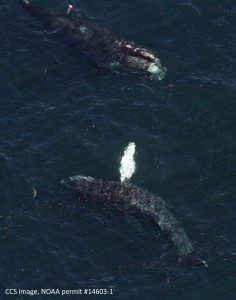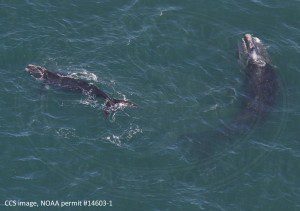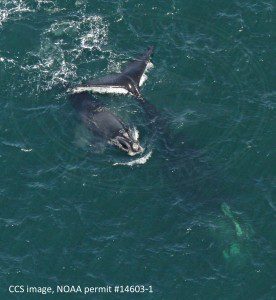April

Right whale #1278 coordinated feeding with unknown individual in Cape Cod Bay on March 6, 2016. CCS image taken under NOAA permit #14603-1
April 6, 2016
The very unwelcome winter storm earlier this week prevented us from getting more field days in during this usual busy time. Thankfully, the forecast for Wednesday morning was for low winds, so we took off early to cover as much of the area as possible before the sea state deteriorated.
We started our survey travelling south to north along the Outer Beach (transect 16), and documented the first two right whales of the day off Eastham and Wellfleet; these were the first right whales observed on that line this season.
Continuing the survey along the northernmost track line in Cape Cod Bay, we observed many humpback and fin whales as well as right whales. In one small area we spotted about 14 individual right whales – all feeding – including two newly arrived mom/calf pairs! These moms were identified as EgNo 3405, Fuse and EgNo 3317. Close to 40 more feeding right whales were documented (including early arrival EgNo 1233 and her calf) before landing at the Chatham Municipal Airport to refuel.
After fueling the winds picked up and the sea state was much higher, but we were still able to document a few more right whales, including the fourth mom of the day, EgNo 3860, Bocce and her calf.

Right whale #3950 subsurface feeding in close proximity to a humpback whale. Cape Cod Bay, April 9, 2016. CCS image taken under NOAA permit #14603-1
April 9, 2016
What a difference a few days make. Today, while conducting a survey flight hardly 72 hours after the most recent Bay survey on Wednesday, a very different right whale occupancy in Cape Cod Bay was documented. Skymaster took off early to mitigate the high winds predicted later in the afternoon (a trend this April), and began the survey in calm conditions in the north of the Bay.
To the team’s surprise more humpback whales than right whales were observed (31 versus 29), including the two species in close proximity to each other in the northern part of the Bay!
The right whales documented were predominately subsurface feeding throughout the survey area, and included familiar individuals like EgNo 4020 Nymph, EgNo 3802 Portato, and moms EgNo 1233 and EgNo 3860 Bocce with their calves. Both Nymph and Portato are the female offspring of frequent Cape Cod Bay visitors, EgNo 1620 Mantis and EgNo 1802 Legato respectively, and were seen here in their first few years of life.
So where did the rest of the right whales go? We don’t know, and with little survey effort currently being conducted outside of this habitat it is difficult to find out. The drop in numbers is not uncommon – right whales travel in and out of the CCS survey area all of the time – so it’s possible that the former high numbers will be reached again later this month. The team is curious, as we hope you are, about what and who we will see on our next flight – stay tuned!

Right whales #3115 (Harmony) and 2016 calf, subsurface feeding in Cape Cod Bay with #4023, Wolverine. CCS image taken under NOAA permit #14603-1
April 13, 2016
The CCS aerial survey team flew again on Wednesday in a hard push to understand the dynamics of what is occurring in the Bay. Is there a shift in number of individual right whales in the Bay, or are the right whales still transiting in and out?
Once again, we observed many humpback and fin whales in the northern section of the survey area. We began to see right whales closer to the middle of the Bay; these individuals were all subsurface feeding, making the collection of identification photographs somewhat difficult. However, the reward was some familiar faces: Nymph (EgNo 4020) and Wolverine (EgNo 4023) were still hanging around from the previous flights, and we had EgNo 3333 as another repeat.
Although we have seen EgNo 3333 on many flights since the end of February, we are happy to have extra opportunities to observe this individual. EgNo3333, a 13 year old male, has scars from an entanglement in 2008 and is one of many right whales being monitored for a continuing health assessment. He is the fourth known calf of EgNo1233, who was also spotted today with her 2016 calf – her sixth so far!
Along with some of this season’s regulars, there continues to be an influx of moms with calves and new whales. Bocce (EgNo 3860) and Fuse (EgNo 3405) with their 2016 calves were again documented and, for the first time this season, Harmony (EgNo 3115) with her third known calf. Also documented were were Aries (EgNo 2215) and EgNo 1307, two males not previously observed in Cape Cod Bay during the 2016 season.
While the numbers of right whales from this last flight were still hovering in the low 30s, it’s anyone’s guess as to how the last few weeks of the season will play out. From the research CCS’s habitat team conducts we know there’s at least some food prey source in the water keeping the whales in the Bay.
It’ll be great for the aerial and vessel teams to get out again soon and continue to document these trends. Here’s hoping for fair winds in the next few days!

Right whale #3860 (Bocce) and 2016 calf feeding in Cape Cod Bay on April 17, 2016. CCS image, NOAA permit #14603-1
April 17, 2016
We took off a little later this Sunday to allow for the winds to come down and though there was still a bit of a swell, conditions were nicer than forecasted. Flying the track lines from north to south nothing was sighted on the backside, nor on the first few track lines in the Bay. As the survey continued south small groups of right whales were observed, with a total of 21 individuals documented. After refueling the survey was finished without observing any additional right whales.
The right whales that were documented included 4 moms with calves, and two calves were seen interacting with each other! Other than that there were a lot of the same individuals that have been documented over the last few flights and nearly all the right whales were feeding.

Right whale #3115 (Harmony) and 2016 calf feeding in Cape Cod Bay on April 18, 2016. CCS image taken under NOAA permit #14603-1
April 18, 2016
Having seen a decline in number of individuals in Cape Cod Bay during Sunday’s flight, a survey in the Bay was conducted on Monday. This time, the survey started in the southern part of the Bay. Working north, nothing was observed until we starting on the fifth transect line, where recent regulars in the Bay EgNo 1233 and her calf were documented. Considering this pair was not documented on Sunday’s flight, it was good to confirm they were still hanging around. 1233 was subsurface feeding, hopefully refueling her reserves after calving. Her calf this year is also becoming a fast favorite, as it is one of the bigger calves seen in the Bay this year, a rotund new addition to the population.
Continuing northwards, two other moms with calves, EgNo’s 3317 and 3115 (Harmony), were documented along with a CCB intermatch code M076. While this individual hasn’t yet been matched to a whale in the catalog, it has been documented in the Bay during the last two seasons. The catalog curators at the New England Aquarium will either match this to a known whale or, if it continues to be documented, possibly add it to the catalog as a new whale. In the meantime, CCS gives it an “intermatch” code so this individuals sightings can be efficiently tracked in-house.
All in all, a total of 10 individuals were observed during this flight, with no new individuals were documented. The good news is that these whales were still subsurface feeding. However, it leaves us wondering if this is an early end to the season or if there will be an influx of individuals back into the Bay. Only time (and more survey days) will tell! In the meantime, the hope is to continue riding this weather window and fit in a survey along the east side of Cape Cod tomorrow. Fingers crossed some individuals heading into the Bay are sighted!

Our Work
Humpback Whale Research
Right Whale Research
Marine Animal Entanglement Response
Marine Geology Department
Water Quality Monitoring Program
Marine Fisheries Research
Seal Research
Shark Research
Marine Education
Interdisciplinary
Marine Debris and Plastics Program
Marine Policy Initiative
Cape Cod Climate Change Collaborative
Publications

